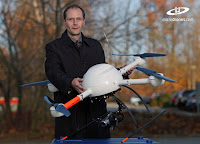Being a big science fiction fan and having law enforcement experience, I naturally watched the “Robocop” series, not for the acting but for the cool gadgets and wondered how long it would take for present day officers to get those types of toys.
Well, we are closer than you think.
Instead of ordering a plain-Jane, off-the-shelf car from one of the big three automakers and paying extra to have the vehicle outfitted with extra wires, lights, siren, prisoner compartments and such, Carbon Motors have come up with a prototype police vehicle, the E7, designed by police officers, that can be made to any specification the police need. Options include; explosive detectors, armored doors and dashboards, and cameras. The rest of the vehicle is equipped with police ready features such as custom colored fenders, so additional paint is not needed by the purchasing agencies to match their color schemes. Performance is through a clean burning diesel engine that exceeds most of the patrol cars out there. Life span would be approximately 3X’s that of current vehicles. (www.carbonmotors.com)
As long as we are talking about the patrol car, how about the “smart” system integrated into the car?
“Project 54” is a system that lets the officer control the electronics of the car by voice. For example, the officer could have a license plate checked for wants and registration simply by saying the plate number out loud. The computer would give a return, out loud, without the officer touching a keyboard or taking his/her eyes off the road. When the officer initiates the car stop, a voice command turns on the emergency equipment and activates the video recording. After the stop, the officer can check on the driver’s license and any wants/warrants the driver may have. Currently, the system is in use in four-wheeled vehicles and motorcycles also. (www.policeone.com).
More smart stuff?
How about a “Automatic License Plate Recognition” (ALPR) camera?
Cameras are mounted on the patrol vehicle, facing forward and to the sides. The cameras send the pictures of the scanned license plates to a processor in the vehicle and checks them against known Amber Alerts, stolen vehicle and wants/warrants lists. Again, the officer doesn’t have to fiddle with a keyboard, or take eyes off the roadway. This particular system is already in use and is slightly expensive at approximately $25,000.00 per unit. www.avigilon.com
I would think the insurance industry would help forgo the costs on ALPR as it would help in recovery rates and reduce their payouts.
How about the crowd control scenario?
This is real Robocop stuff.
Officers equipped with this sleeve/glove combo have a digital display, 50,000 volts, shielding, HD camera, flashlight and customizable features. Officers can intimidate potential threats with a spark display and stun suspects with 50,000 volts if they come in contact with the officer. Further upgrades could include “TASER” projectile probes, so the officer could “reach out and touch” someone. (policeone - bionic arm)
How about surveillance? Our childhood fantasies have come true.
The “microdrone” is the police version of the military’s UAV (unmanned aerial vehicle) without the weaponry (so far). It can beam back video footage, in the day and night, flying almost silently overhead the bad guys. It’s currently in use by the British Transport Police to catch metal thieves. One accessory is a “squirt gun” used to mark suspects for later identification. Opponents to this $50,000.00 toy claim this is another “Big Brother” spying technique. (microdrones.com)
Ever wished you had a cannon on your patrol car? Your wish is about to come true.
Enter the “Starchase GPS Launcher”. The mortar type barrel fires a shell resembling an artillery shell containing a GPS device and a sticky point that glues itself to the suspect’s car. Police then can track the vehicle’s movements at their leisure. (starchase)
Of course there are other advances involving ammunition, clothing, protective gear, knives, mini cameras and such and that would require a bit of time and research on the purchaser’s desires, but when looking at the best bang for the buck, these “toys” really make sense.
A car that is already equipped from the factory for police work and has 3X’s the life of a normal patrol car for a little more than the price already being paid.
A “handsfree” control system that doesn’t require the officer to be fumbling with a radio microphone, keyboard on a mounted computer, switching his overhead emergency lights on and off by hand; it enables he or she to focus on the job at hand, enhancing the officer’s safety.
An automatic license plate scanning system that requires hardly any effort from the officer. Multiplies the output by 100 fold with results you cannot argue about. Citizens would love the reduced time for recovering their stolen vehicles. Fugitives could be located easier. Missing children also. Just by driving the patrol car down the street or alley.
A system worn like a glove, still giving the officer manual dexterity, protection, defense, recording ability and respect.
Since many police department do not like or prohibit vehicle pursuits, a system that allows an officer to “mark” a fleeing vehicle that could be easily tracked from a remote location and apprehended when the timing is appropriate.
Sure, they cost. But what does it cost for a life? A lawsuit? Property Damage? The initial cost would be worth it even in only one situation.
It’s a shame that administrations only look at the initial costs, not long term.






No comments:
Post a Comment